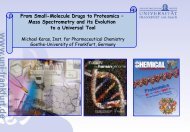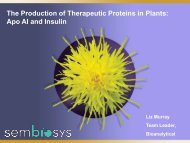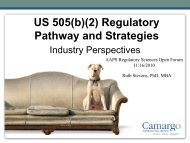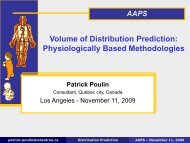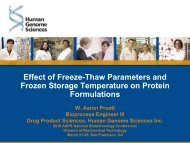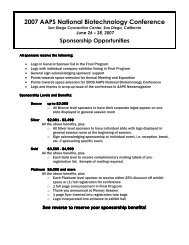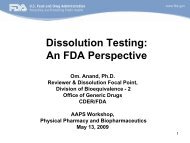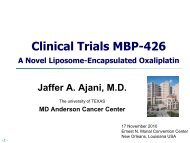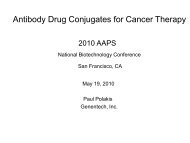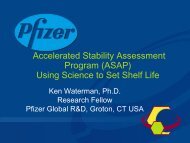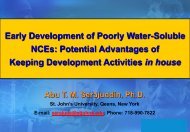"Excipient Innovation and Regulatory Acceptance for use in Drug ...
"Excipient Innovation and Regulatory Acceptance for use in Drug ...
"Excipient Innovation and Regulatory Acceptance for use in Drug ...
- No tags were found...
You also want an ePaper? Increase the reach of your titles
YUMPU automatically turns print PDFs into web optimized ePapers that Google loves.
AAPS Hot Topic – November 9, 2009"<strong>Excipient</strong> <strong>Innovation</strong> <strong>and</strong><strong>Regulatory</strong> <strong>Acceptance</strong> <strong>for</strong> <strong>use</strong> <strong>in</strong><strong>Drug</strong> Products – Solubilizer Solutol ®HS 15 Case Study"Ranga Velagaleti, Ph. D., Manager, <strong>Regulatory</strong> Affairs,Pharma Ingredients <strong>and</strong> Services, North AmericaBASF Corporation01.12.2009 Ranga Velagaleti 1
<strong>Excipient</strong> <strong>Innovation</strong> <strong>and</strong> Public Health‣ <strong>Excipient</strong> <strong>Innovation</strong> <strong>for</strong> functionality <strong>and</strong> better drug delivery isone of the primary drivers of recent advances <strong>in</strong> medic<strong>in</strong>e.‣ Majority, if not all, Active Pharmaceutical Ingredients (APIs) knownare poorly soluble <strong>in</strong> water. Development of excipients withsolubilizer <strong>and</strong> other functionalities have advanced the <strong>use</strong> ofthese poorly soluble APIs <strong>in</strong> modern day therapies.‣ For example, <strong>use</strong> of (then) novel excipient, Polyoxyl 35 castor oilNF (Cremophor EL), <strong>for</strong> solubilization <strong>and</strong> consequentbioavailability of poorly soluble APIs <strong>for</strong> improved efficacy enableddrug development <strong>in</strong> 1990s <strong>for</strong> life-threaten<strong>in</strong>g Cancer [Taxol(Placitaxel)] <strong>and</strong> AIDs (e.g., Norvir, Ritonavir, Kaletra) diseases.01.12.2009 Ranga Velagaleti 2
<strong>Innovation</strong> is Historical <strong>and</strong> Cont<strong>in</strong>u<strong>in</strong>g- Polymerization of N-V<strong>in</strong>ylpyrrolidone‣ <strong>Innovation</strong> of Synthetic Polymer excipients has been the hall markof early drug development.‣ The first polymerization product of N-v<strong>in</strong>ylpyrrolidone was solublepolyv<strong>in</strong>yl pyrrolidone (Povidone USP), patented <strong>in</strong> 1939.‣ Besides <strong>in</strong>novative polymerization chemistry, process<strong>in</strong>gtechniques such as spray dry<strong>in</strong>g <strong>and</strong> roller-dry<strong>in</strong>g have been partof early <strong>in</strong>novations <strong>in</strong> f<strong>in</strong>ished excipient development.‣ For example, low <strong>and</strong> medium molecular weight grades of solublePovidone products are spray-dried (K 12, 17, 25, 30) while highmolecular grades are roller-dried (K-90) to manufacture the f<strong>in</strong>alf<strong>in</strong>ished excipient product.01.12.2009 Ranga Velagaleti 3
<strong>Innovation</strong> <strong>in</strong> Polymerization Control -<strong>for</strong> Diversity <strong>in</strong> Functionality‣ The mechanism of term<strong>in</strong>at<strong>in</strong>g polymerization reaction makes itpossible to produce soluble Polyv<strong>in</strong>ylpyrrolidone of almost anymolecular weight.‣ This <strong>in</strong>novation lead to soluble Povidone grades of variousmolecular weights, e.g., Povidone K12, K17, K25, K30 <strong>and</strong>K90.‣ The vary<strong>in</strong>g molecular weights <strong>and</strong> viscosity properties ofsoluble Povidones exp<strong>and</strong>ed their functionality <strong>and</strong> enabled<strong>use</strong> <strong>in</strong> a diverse portfolio of dosage <strong>for</strong>ms, i.e., <strong>in</strong>jectable,solution, suspension (K 12, K 17), <strong>and</strong> solid dosage <strong>for</strong>ms (K25to K90).01.12.2009 Ranga Velagaleti 4
<strong>Innovation</strong> with<strong>in</strong> the Same Chemistry -<strong>for</strong> Different Functionality‣ <strong>Innovation</strong> also <strong>in</strong>volved physical <strong>and</strong> chemical variation ofsame polymerization chemistries. For example, <strong>in</strong>solublePovidone (cross-l<strong>in</strong>ked polyv<strong>in</strong>ylpyrrolidone; Crospovidone NF)was prepared by popcorn polymerization or proliferativepolymerization of soluble polyv<strong>in</strong>ylpyrrolidone (Povidone USP).‣ Insoluble Crospovidone is considered to have the samechemistry (polyv<strong>in</strong>ylpyrrolidone) as soluble Povidone <strong>and</strong> hasthe CAS number 9003-39-8 as Povidone, but different <strong>in</strong>functionality – Povidone is considered an excellent b<strong>in</strong>derwhereas Crospovidone is considered one of the superdis<strong>in</strong>tegrants <strong>for</strong> solid oral dosage <strong>for</strong>ms.01.12.2009 Ranga Velagaleti 5
Results of Discovery <strong>and</strong> <strong>Innovation</strong> –St<strong>and</strong>ard, Mixed, Co-processed <strong>and</strong> Novel<strong>Excipient</strong>sOver the years, excipient <strong>in</strong>novation <strong>and</strong> discovery lead to a numberof excipients which can be categorized as:‣ St<strong>and</strong>ard <strong>Excipient</strong>s – Monographed; e.g., Poloxamer, PEG‣ Mixed <strong>Excipient</strong>s – Generally two or more monographedexcipients by simple mix<strong>in</strong>g, blend<strong>in</strong>g; <strong>in</strong>dividual excipientsneed quantitation from the mixture.‣ Co-Processed <strong>Excipient</strong>s – Generally two or more monographedexcipients by more complex high shear mix<strong>in</strong>g etc.; <strong>in</strong>dividualexcipients need quantitation from the mixture.‣ Novel <strong>Excipient</strong>s – New chemical entities‣ See IPEC <strong>Excipient</strong> Composition Guide <strong>for</strong> details.01.12.2009 Ranga Velagaleti 6
Novel <strong>Excipient</strong>s – Def<strong>in</strong>ition <strong>and</strong><strong>Regulatory</strong> Requirements‣ Novel <strong>Excipient</strong> is a new chemical entity; a new <strong>in</strong>novationthat has not been <strong>use</strong>d <strong>in</strong> any drug approved by regulatoryauthorities,‣ or‣ A comb<strong>in</strong>ation of excipients conta<strong>in</strong><strong>in</strong>g new chemicalentity/entities (not <strong>in</strong> approved drugs) <strong>and</strong> excipients that arealready <strong>in</strong> approved drugs <strong>in</strong> a mixed or co-processedscenario.01.12.2009 Ranga Velagaleti 7
Novel <strong>Excipient</strong>s – Def<strong>in</strong>ition <strong>and</strong><strong>Regulatory</strong> Requirements‣ Novel excipients require extensive safety evaluation asspecified <strong>in</strong> the follow<strong>in</strong>g FDA guidance.‣ FDA Guidance <strong>for</strong> Industry: Noncl<strong>in</strong>ical Studies <strong>for</strong> theSafety Evaluation of Pharmaceutical <strong>Excipient</strong>s, May 2005– “It is important to per<strong>for</strong>m risk-benefit assessments onproposed new excipients <strong>in</strong> drug products <strong>and</strong> to establishpermissible <strong>and</strong> safe limits <strong>for</strong> these substances”‣ Solutol ® HS 15 Polyoxyl 15 Hydroxystearate is discussed as anexample of a novel excipient <strong>in</strong> this presentation. <strong>Excipient</strong> evaluationdur<strong>in</strong>g drug approval process by FDA is described first, followed byIPEC-<strong>in</strong>itiated Solutol HS 15 review.01.12.2009 Ranga Velagaleti 8
General <strong>Regulatory</strong> Review Process <strong>for</strong><strong>Excipient</strong>s – FDA Approved <strong>Drug</strong>s‣ <strong>Excipient</strong>s are not approved or rejected by FDA. They arereviewed only <strong>in</strong> the context of a drug product application.‣ Manufacturer (<strong>Drug</strong> Master File Holder; DMF) of an excipient submitsa Type IV (excipient) DMF to FDA. FDA issues a DMF number, <strong>and</strong>enters <strong>in</strong> DMF database on FDA website. DMF documents areho<strong>use</strong>d at FDA <strong>and</strong> the contents are kept confidential.‣ With the <strong>in</strong>tent of us<strong>in</strong>g an excipient <strong>in</strong> their drug product <strong>for</strong>mulation<strong>and</strong> fil<strong>in</strong>g (NDA/ANDA/NADA or their supplements), drug productmanufacturer requests DMF Holder <strong>for</strong> a DMF access letter. DMFHolder provides access letter to FDA, with a copy to requester.‣ With the access letter from DMF Holder, FDA reviews excipient DMFdur<strong>in</strong>g review of drug product application.01.12.2009 Ranga Velagaleti 9
General <strong>Regulatory</strong> Review Process <strong>for</strong><strong>Excipient</strong>s‣ Questions related to excipient DMF, are sent as a DMFdeficiency letter to DMF holder directly by FDA.‣ <strong>Drug</strong> product safety is determ<strong>in</strong>ed by regulators from precl<strong>in</strong>icalsafety (animal toxicology), <strong>and</strong> Phase 1, 2, <strong>and</strong> 3 humancl<strong>in</strong>ical data with Placebo (conta<strong>in</strong><strong>in</strong>g excipients without an API)run simultaneously with f<strong>in</strong>ished drug product.‣ <strong>Drug</strong> product safety assessment provides <strong>in</strong><strong>for</strong>mation related tosafety of excipients (placebo) as well as safety <strong>and</strong> stability ofAPI <strong>in</strong> the presence of excipients (drug product).01.12.2009 Ranga Velagaleti 10
General <strong>Regulatory</strong> Review Process <strong>for</strong><strong>Excipient</strong>s - IIG List<strong>in</strong>g‣ Once a drug product is approved, FDA lists the excipients <strong>use</strong>d <strong>in</strong> theapproved drug product <strong>in</strong> FDA’s Inactive Ingredient (IIG) Database.‣ Generally monograph name of excipient, dosage <strong>for</strong>m <strong>and</strong> amountper dosage unit are listed.‣ <strong>Excipient</strong> br<strong>and</strong> names are not listed. <strong>Drug</strong> product names are notmentioned <strong>in</strong> the IIG database.‣ For mixed <strong>and</strong> co-processed excipients, <strong>in</strong>dividual components arespecified as stated <strong>in</strong> the drug application.‣ First time <strong>use</strong> Novel <strong>Excipient</strong>s are listed by chemical name.‣ USP consults FDA on nomenclature <strong>for</strong> official monographs.01.12.2009 Ranga Velagaleti 11
Novel <strong>Excipient</strong>s – Constra<strong>in</strong>ts <strong>for</strong> First-Time Use <strong>in</strong> <strong>Drug</strong> Products‣ <strong>Drug</strong> product manufacturers are underst<strong>and</strong>ably risk averse <strong>in</strong>us<strong>in</strong>g Novel excipients that have not been <strong>use</strong>d <strong>in</strong> FDA (orother regulators around the world)-approved drugs.‣ Primary concern is that a delay from questions on the excipient<strong>use</strong>d could ca<strong>use</strong> delay <strong>in</strong> drug approvals.‣ If a novel excipient is functionally superior over the exist<strong>in</strong>gexcipients <strong>and</strong> has other desirable <strong>for</strong>mulation, efficacy <strong>and</strong>safety advantages, <strong>use</strong> of such excipient is very attractive.‣ Our experience suggests that FDA encourages <strong>use</strong> of new <strong>and</strong>novel excipients provided safety <strong>in</strong><strong>for</strong>mation is adequate.01.12.2009 Ranga Velagaleti 12
IPEC-Americas Initiative <strong>for</strong> Novel <strong>Excipient</strong>Review by FDA – BASF Solutol HS 15‣ <strong>Regulatory</strong> concurrence of an excipient be<strong>for</strong>e <strong>use</strong> <strong>in</strong> approveddrugs is desirable, but there are no avenues to facilitate this.‣ IPEC-Americas has worked with FDA over past several yearslead<strong>in</strong>g to acceptance of one novel excipient safety review ascase study by FDA - ahead of drug product approval toencourage novel excipient <strong>and</strong> <strong>for</strong>mulation <strong>in</strong>novation.‣ IPEC Novel <strong>Excipient</strong> Safety Evaluation Procedure wasdesigned by IPEC-Americas <strong>Excipient</strong> Safety Committee <strong>and</strong>conta<strong>in</strong>ed a process flow as outl<strong>in</strong>ed below.‣ IPEC Safety Committee → BASF <strong>and</strong> Wyeth → Aclairo →IPEC Safety Committee → FDA (see details next page)01.12.2009 Ranga Velagaleti 13
IPEC Novel <strong>Excipient</strong> Safety EvaluationProcedure - The Process with SolutolHS 15‣ IPEC-Americas <strong>Excipient</strong> Safety Committee <strong>in</strong>itiated a processof selection of the first Novel <strong>Excipient</strong> <strong>for</strong> FDA review.‣ Dr. Jay Goldr<strong>in</strong>g, IPEC Safety Committee Chair at that time(<strong>and</strong> <strong>for</strong>merly Director, Toxicology at Wyeth) <strong>in</strong><strong>for</strong>med BASFthat the excipient Solutol ® HS 15 (solubilizer) was selected asthe first excipient under IPEC Novel <strong>Excipient</strong> SafetyEvaluation Procedure. Dr. Goldr<strong>in</strong>g coord<strong>in</strong>ated thesubsequent steps of IPEC Safety Evaluation Procedure.‣ Dr. Sherry Ku, Senior Director, Formulation Development atWyeth encouraged this <strong>in</strong>itiative <strong>and</strong> participated <strong>in</strong> the projectthrough <strong>in</strong>puts on Solutol ® HS 15 human cl<strong>in</strong>ical safety toAclairo.01.12.2009 Ranga Velagaleti 14
IPEC Novel <strong>Excipient</strong> Safety Review -BASF Solutol HS 15‣ The IPEC Novel <strong>Excipient</strong> Safety Review Procedure requiredBASF to submit a safety evaluation package to Aclairo, an<strong>in</strong>dependent toxicology consult<strong>in</strong>g firm under an IPEC-Aclairoagreement <strong>for</strong> novel excipient evaluation.‣ BASF prepared a comprehensive technical <strong>and</strong> safety packageto Aclairo on Solutol ® HS 15 that <strong>in</strong>cluded but not limited to: Technical In<strong>for</strong>mation - chemistry, manufactur<strong>in</strong>g, processcontrols, release <strong>and</strong> stability specifications <strong>and</strong> data; Toxicology reports <strong>in</strong>clud<strong>in</strong>g acute <strong>and</strong> subchronic toxicitystudies – Oral <strong>and</strong> IV routes of adm<strong>in</strong>istration.01.12.2009 Ranga Velagaleti 15
IPEC Novel <strong>Excipient</strong> Safety Review -BASF Role‣ BASF prepared a comprehensive technical <strong>and</strong> safety package <strong>for</strong>Solutol HS 15 <strong>for</strong> submission to Aclairo that <strong>in</strong>cluded: Dermal <strong>and</strong> Eye Irritation Studies; Genotoxicity Studies; Reproductive toxicity Studies; BASF Internal Safety Expert Evaluation Report; Safety Evaluation Assessment by EMEA;In<strong>for</strong>mation on related chemistries listed <strong>in</strong> FDA IIG.01.12.2009 Ranga Velagaleti 16
IPEC Novel <strong>Excipient</strong> Safety Review -Review by Aclairo <strong>and</strong> FDA‣ After review of data package provided by BASF, Aclairoprovided a report conta<strong>in</strong><strong>in</strong>g safety assessment from threeexpert toxicologists <strong>for</strong> Solutol ® HS 15 to BASF.‣ Wyeth provided human cl<strong>in</strong>ical safety data of a drug product<strong>for</strong>mulation conta<strong>in</strong><strong>in</strong>g Solutol HS 15 to Aclairo directly.‣ BASF Submitted Aclairo Safety Evaluation report <strong>and</strong> safetydata package to IPEC Safety Committee Chair.‣ IPEC Safety Committee Chair submitted a comprehensiveSolutol ® HS 15 safety package to FDA <strong>in</strong>clud<strong>in</strong>g the Aclairoevaluation of human cl<strong>in</strong>ical data.01.12.2009 Ranga Velagaleti 17
IPEC Safety Evaluation of Solutol® HS 15<strong>and</strong> USP/NF Monograph‣ IPEC Safety Committee Chair received a response from FDAon their assessment of Solutol ® HS 15 safety.‣ BASF <strong>in</strong><strong>for</strong>med USP about Solutol ® HS 15 safety evaluation byFDA under the IPEC Novel <strong>Excipient</strong> Safety EvaluationProcedure.‣ USP consulted FDA’s Compendial group on this subject <strong>and</strong>decided to develop a official monograph.‣ USP has published an official monograph on Solutol ® HS 15“Polyoxyl 15 Hydroxystearate NF” <strong>in</strong> Pharmacopeial Forum(PF), January-February 2009 issue.01.12.2009 Ranga Velagaleti 18
Summary‣ <strong>Excipient</strong> <strong>Innovation</strong> <strong>for</strong> functionality <strong>and</strong> better drug delivery is oneof the primary drivers of recent advances <strong>in</strong> medic<strong>in</strong>e.‣ Innovative New <strong>and</strong> Novel <strong>Excipient</strong>s are <strong>use</strong>d by drug productmanufacturers based on their superior functionality over exist<strong>in</strong>gexcipients or suitability <strong>for</strong> unmet <strong>for</strong>mulation needs.‣ Solutol ® HS 15 is the first novel excipient reviewed under theIPEC Novel <strong>Excipient</strong> Safety Evaluation procedure by FDA -ahead of its <strong>use</strong> <strong>in</strong> a FDA-approved drug product.‣ Follow<strong>in</strong>g this review, Polyoxyl 15 Hydroxystearate NF (Solutol ®HS 15) monograph has been published <strong>in</strong> January-February 2009issue of USP Pharmacopeial Forum (PF).01.12.2009 Ranga Velagaleti 19



